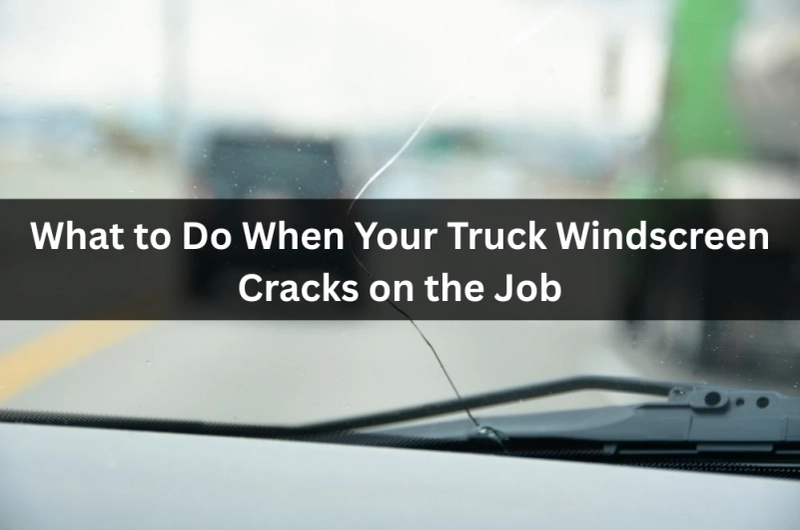It always happens on a deadline. A stone flicks up, a faint star blooms, and within a few kilometres the line starts creeping. The worst thing you can do is pretend nothing changed. Pull over somewhere safe, breathe, and switch to a calm checklist. Think visibility, structural soundness, and the next safe stop—not the last delivery. When time matters, arrange urgent truck windscreen service as part of the plan, not as a last resort. That choice turns a stressful detour into a controlled pit stop and saves the cab from becoming an improvised workshop on the shoulder.
First minutes after the impact
Small decisions in the first five minutes set the tone for the rest of the shift. Keep the truck, the load, and everyone around you out of harm’s way while you decide on the next move.
- Safe pull-over: Choose a shoulder or bay with clear sight lines and space to re-enter traffic without sudden swerves.
- Damage snapshot: Take quick photos inside and out, including the dash view, so the crack’s growth is easy to compare later.
- Clean sight path: Brush away loose glass granules and dust; don’t touch the fracture edges, which can spread with pressure.
- Route rethink: Shift to a gentler road if possible; rough surfaces and sharp steering inputs accelerate crack propagation.
These steps bring clarity. With a tidy scene and a stable view, the next choice—keep rolling slowly or park for assistance—becomes simpler and less emotional.
Safety, legality, and when to stop
Cracks are not only annoying; they can breach basic roadworthiness rules when they enter the driver’s primary field of view or compromise structural integrity during a collision. Understanding how safety systems expect visibility helps you judge the threshold between “manage” and “must stop.”
- Primary view matters: Damage intruding on critical sight zones multiplies risk at intersections and in low sun, even if it looks small.
- Edge cracks behave worse: Fractures touching the perimeter can spread fast because the screen’s support and stress profile change near the frame.
- Vibration accelerates growth: Corrugations, potholes, and aggressive wipers turn hairlines into branches within minutes.
- Night and rain amplify hazard: Glare and refracted headlight scatter from cracks exhaust the eyes and slow reaction times.
Modern cabins rely on clear glass for sensors and passive safety. Context from truck safety features explains how visibility and structural elements contribute to protection, which is why a compromised windscreen deserves prompt, measured action.
Temporary stabilisation to get you home safe
If conditions allow you to move carefully toward a depot or service point, small stabilising steps reduce further damage without pretending they’re a fix.
- Gentle cabin climate: Keep temperature changes gradual; blasting demisters or cold air across the crack invites sudden growth.
- Avoid wash-wipe shocks: Hold off on high-speed wipers; use wthe asher sparingly and consider a soft microfiber to dab at mist.
- Steering with care: Smooth inputs and wider lines around rough patches limit torsion that twists the cab and screen.
- Speed discipline: Drop to a comfortable pace where you can scan further ahead and avoid abrupt braking at debris.
These measures are a bridge, not a solution. They buy you a safer window to organise assistance and prevent a manageable fracture from turning into a full-length split.
Repair or replace: making the smart call
Not every crack means a brand-new screen, but some defects are poor candidates for resin. The decision blends location, length, age of damage, and how your route treats the cab day to day.
- Size and position: Long or edge-connected cracks are usually replacement territory; central chips caught early may repair cleanly.
- Age of the fracture: Old, dirty cracks resist bonding; the clearer and newer the mark, the better the repair outcomes.
- Sensor considerations: Camera brackets, heaters, and rain sensors complicate both repair and replacement choices and calibration.
- Duty cycle reality: Heavy routes with corrugations or quarry access demand conservative calls; false economies rarely last.
When in doubt, lean on clear signals rather than hope. A quick refresher on signs for a truck windscreen replacement helps you recognise the tipping points that make replacement a safer, cheaper long-term decision.
Managing cost, time, and downtime pressure
The goal is to keep operations predictable while keeping people and freight safe. Planning for the occasional screen emergency turns chaos into a scheduled pause.
- Pre-approved vendors: Having details on file speeds dispatch, quotes, and onsite access checks when minutes matter.
- Calibration booked with glass: If cameras or ADAS are present, bundle calibration with replacement to avoid a two-step delay.
- Weather-aware timing: Align work windows with forecast gaps; adhesives and curing play nicer in certain conditions.
- Insurance clarity: Know excess, coverage for mobile service, and documentation needed so claims don’t stall the truck.
Good information keeps stress low. Industry summaries everything about truck windscreens, and outlines terminology and common service steps relevant to fleet routines.
A quick case from the road (what worked and why)
A morning run on the outskirts turned noisy when a ute flicked gravel just before a merge. The star sat low on the passenger side, short of the wiper arc. I pulled into a wide shoulder, photographed inside and out, and checked edges for movement. With visibility intact and no frame contact, I eased the cabin climate to neutral and mapped a slower route to a service bay. Calling ahead meant the techs had the right glass and sealant staged. Keeping steering smooth and speeds modest, the crack barely grew. Replacement and camera calibration were done inside a single shift window, and the rest of the week ran to plan. The lesson wasn’t heroic—just a calm checklist: stabilise, document, decide, and book help that understands heavy vehicles. That order protects eyes, schedules, and the quiet confidence that the next trip will feel uneventful—the best feeling a driver can ask for.


